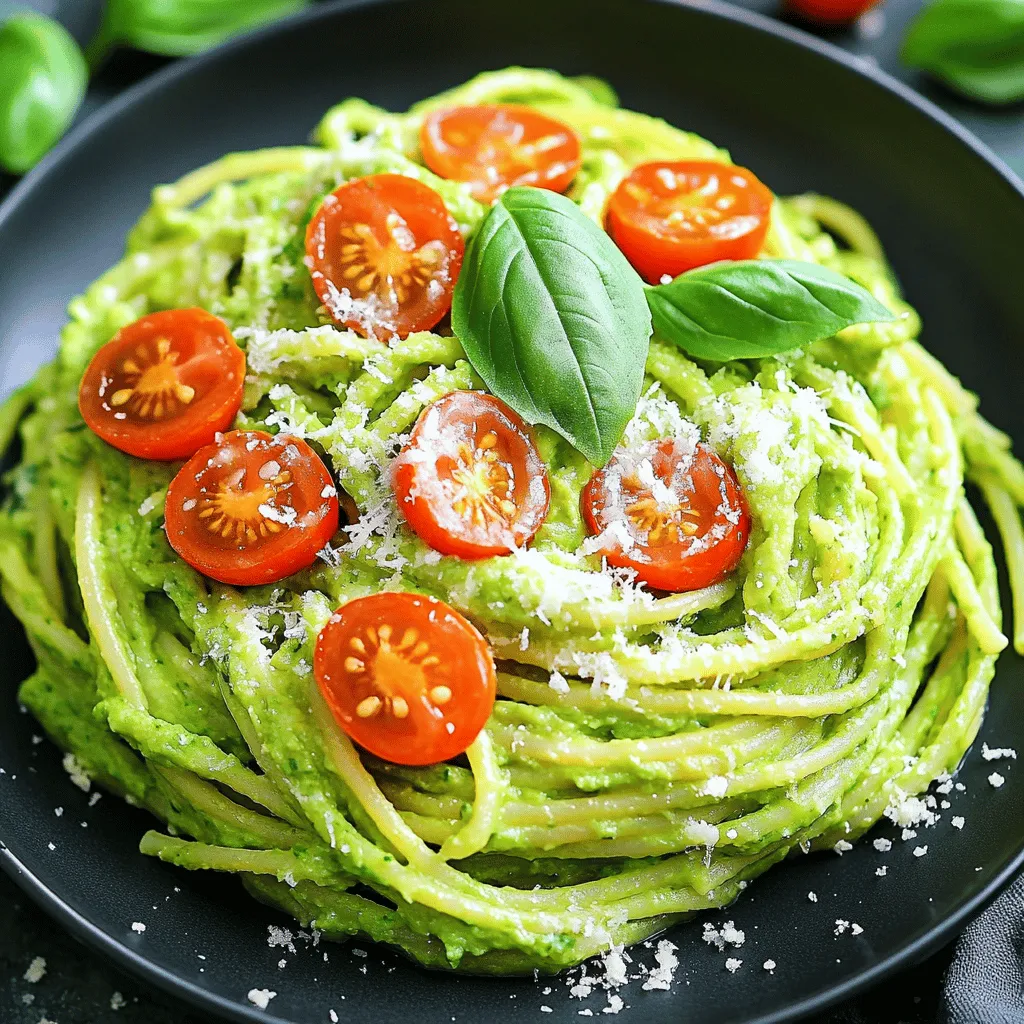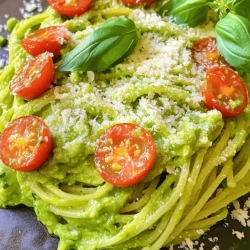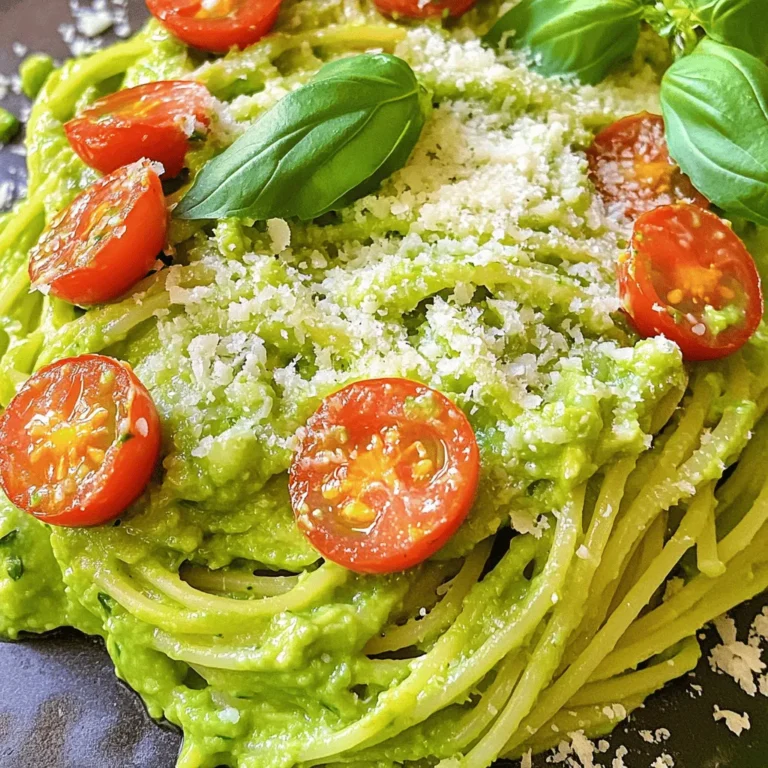Looking for a quick, healthy meal that tastes amazing? Creamy Avocado Pasta is the answer! In just minutes, you can whip up this tasty dish that’s packed with flavor and nutrition. I’ll guide you through easy steps to create this delightful meal using ripe avocados and simple ingredients. Whether you’re cooking for yourself or impressing guests, this recipe is sure to please. Let’s get started on this creamy adventure!
Ingredients
Essential Ingredients for Creamy Avocado Pasta
To make creamy avocado pasta, you need just a few basic items. Here’s what you will need:
– 2 ripe avocados, pitted and peeled
– 2 cloves garlic, finely minced
– 2 tablespoons freshly squeezed lemon juice
– 1/4 cup extra virgin olive oil
– 1/2 cup fresh basil leaves, tightly packed
– 1/4 teaspoon red pepper flakes (optional)
– Sea salt and freshly cracked black pepper, to taste
– 8 oz. spaghetti or your favorite pasta
– Grated Parmesan cheese, for serving (optional)
– Halved cherry tomatoes, for garnish (optional)
These ingredients come together to create a smooth, rich sauce. The avocados provide a creamy base, while garlic and basil add depth.
Optional Ingredients for Extra Flavor
You can play with flavors by adding a few more ingredients. Here are some ideas:
– A splash of vegetable broth for more depth
– Fresh herbs like parsley or cilantro
– Nuts like pine nuts or walnuts for texture
– A squeeze of lime juice for a zesty kick
These extras can enhance the flavor and make the dish even more exciting. Feel free to mix and match based on your taste.
Ingredient Substitutions
Don’t have all the ingredients? No worries! Here are some substitutions you can use:
– Greek yogurt can replace avocados in a pinch for creaminess.
– Use garlic powder if you don’t have fresh garlic.
– Any pasta type works; try penne or gluten-free options.
– Instead of olive oil, you can use avocado oil.
These swaps keep the dish tasty and adaptable. Remember, cooking should be fun and flexible! For the complete cooking instructions, check out the Full Recipe.
Step-by-Step Instructions
Cooking the Pasta
First, fill a large pot with water. Add a good pinch of salt to the water. Bring the water to a boil over high heat. Once boiling, add 8 ounces of spaghetti or your favorite pasta. Cook the pasta until it’s al dente, following the package instructions closely. This usually takes around 8 to 10 minutes. Remember to reserve 1/2 cup of the pasta water before draining the pasta. Drain the pasta and set it aside while you make the sauce.
Making the Avocado Sauce
Now, let’s create the creamy avocado sauce. Take 2 ripe avocados, pit and peel them. Place them in a food processor. Add 2 minced garlic cloves, 2 tablespoons of freshly squeezed lemon juice, and 1/4 cup of extra virgin olive oil. Toss in 1/2 cup of fresh basil leaves and 1/4 teaspoon of red pepper flakes if you like some heat. Season with sea salt and freshly cracked black pepper. Blend all these ingredients until the mixture is smooth and creamy. You may need to scrape down the sides of the processor to blend it well.
Combining Pasta and Sauce
With the pasta cooked and the sauce ready, it’s time to combine them. Return the drained pasta to the pot over low heat. Pour the creamy avocado sauce over the pasta. Add a splash of the reserved pasta water to help the sauce mix in. Gently toss the pasta, ensuring every strand is coated in the creamy sauce. If the sauce seems thick, add more reserved pasta water, a little at a time, until it reaches your desired creaminess. Taste the pasta and adjust the seasoning if needed. Serve the creamy avocado pasta hot, topped with grated Parmesan cheese and halved cherry tomatoes if you like. Enjoy this healthy delight in minutes! For the Full Recipe, check the earlier sections.
Tips & Tricks
How to Select Ripe Avocados
To find the best avocados, look for ones that feel slightly soft. Gently press the skin with your thumb. If it gives a little, it’s ripe. Check the color, too. Dark green or almost black skin often means ripeness. Avoid avocados with large dark spots. They may be bad inside. If your avocados are hard, let them sit on the counter for a few days. They will ripen nicely.
Enhancing the Flavor of the Dish
To boost the taste of your creamy avocado pasta, add fresh herbs. Fresh basil is a must for this dish. You can also try parsley or cilantro for a twist. A sprinkle of lemon zest adds brightness. A dash of red pepper flakes gives heat. Adjust the spice to fit your taste. If you love cheese, a sprinkle of Parmesan elevates the dish.
Perfecting the Creamy Consistency
The key to a smooth sauce is the right blending. Use a food processor for the best results. Blend until the sauce is silky and creamy. If it’s too thick, add a bit of the reserved pasta water. This helps thin it out while keeping it rich. Adjust the creaminess to your liking. A perfect sauce clings to the pasta without being runny.

Variations
Adding Protein Options (Chicken, Shrimp, etc.)
You can add protein to your creamy avocado pasta for a filling meal. Grilled chicken works great. Simply season the chicken with salt and pepper, then grill it until cooked. Slice it thin and mix it in. Shrimp is another tasty option. Just sauté shrimp in olive oil until they turn pink. Add them to your pasta right before serving. You can also use cooked bacon for a smoky flavor.
Vegetarian and Vegan Takes on the Recipe
This dish is easy to make vegetarian or vegan. For a vegetarian option, keep the Parmesan cheese on top. You can sprinkle it for extra flavor. To make it vegan, skip the cheese. Try nutritional yeast instead. It adds a cheesy taste without any dairy. You can also throw in some veggies like spinach or peas for more nutrients. Mix them in right before serving for a fresh touch.
Gluten-Free Pasta Alternatives
If you need gluten-free options, don’t worry! Lots of pasta brands offer gluten-free choices. You can use brown rice pasta or chickpea pasta. Both taste great and have a nice texture. Just follow the cooking instructions on the package. You can also use zucchini noodles for a lighter meal. Spiralize fresh zucchini to make noodles, then sauté them quickly. Serve the creamy avocado sauce on top for a fresh twist.
For more delicious ideas, check the Full Recipe.
Storage Info
How to Store Leftover Creamy Avocado Pasta
To keep your creamy avocado pasta fresh, store it in an airtight container. Make sure to cover it tightly. This helps prevent air from making it brown. I recommend eating it within one to two days for the best taste. You can also add a little lemon juice on top to slow down browning.
Reheating Instructions
When you want to reheat your creamy avocado pasta, do it gently. Place it in a pan over low heat. Add a splash of water or olive oil to help it warm without drying out. Stir well until it’s heated through. You can also use a microwave, but cover it to keep moisture in.
Freezing Tips for the Sauce
If you want to save the avocado sauce, you can freeze it. Pour the sauce into an ice cube tray. Once it’s frozen, pop out the cubes and place them in a freezer bag. This way, you can use it later in other dishes. Just remember to thaw it in the fridge overnight before using.
FAQs
Can I use frozen avocados for this recipe?
Yes, you can use frozen avocados. They work well in this dish. Just thaw them before blending. Frozen avocados may not taste as fresh, but they still add creaminess.
What pasta types work best for creamy avocado pasta?
You can use any pasta type you like. Spaghetti is popular, but you can try penne, fettuccine, or even gluten-free pasta. The key is to choose a shape that holds onto the sauce well.
How can I make this dish spicier?
To add spice, mix in more red pepper flakes. You can also add diced jalapeños or hot sauce. Start with a little, then taste and adjust. Spice makes this dish exciting and fun.
Where can I find the Full Recipe?
You can find the Full Recipe in the section above. It details the ingredients and steps to make creamy avocado pasta. Enjoy making this quick and healthy meal!
In this post, we explored how to make creamy avocado pasta. We covered the key ingredients, step-by-step cooking, and tips for selecting avocados. You learned about tasty variations and how to store leftovers effectively.
This dish is versatile, allowing you to customize it to your taste. Enjoy making it your own, and don’t hesitate to experiment. I hope you find joy in each bite and create meals that you love.


